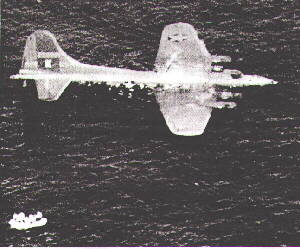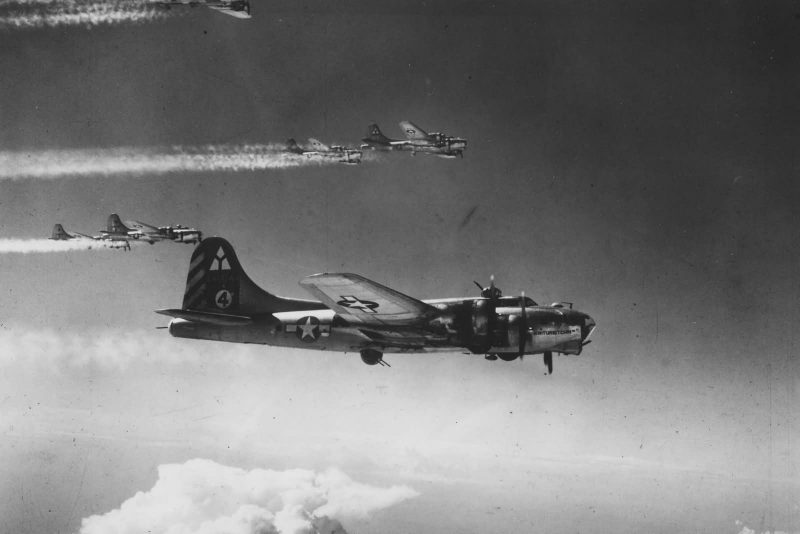Ditching drill is the responsibility of the pilot. Duties should be studied, altered if necessary to agree with any modifications, memorized, and practiced until each member of the crew performs them instinctively.
The pilot’s warning to prepare for ditching should be acknowledged by the crew in the order given here – copilot, navigator, bombardier, flight engineer, radio operator, ball turret gunner, right waist gunner, left waist gunner, and tail gunner, i.e., “Copilot ditching,” “Navigator ditching,” etc.
Upon acknowledgment, crew members remove parachutes, loosen shirt collars and remove ties and oxygen masks unless above 12,000 feet. When preparations for ditching are begun above 12,000 feet, main. oxygen supply or emergency oxygen bottle is used until notification by the pilot. All crew members wearing winter flying boots should remove them. No other clothing should be removed.
Releases on life rafts should not be pulled until the plane comes to rest. Beware of puncturing rafts on wing and horizontal surfaces after launching. The dinghies should be tied together as soon as possible.
Injured men should get first consideration when leaving the airplane.
Life vests should not be inflated inside the plane unless the crew member is certain that the escape hatch through which he will exit is large enough to accommodate him with the vest inflated.
When personnel are in dinghy, stock of rations and equipment should be taken by the airplane commander (or copilot). Strict rationing must be maintained. Flares should be used sparingly and only if there is a reasonable chance that they will be seen by ships or aircraft. Don’t forget the Very pistol. Lash the life rafts together.
Landing crosswind is recommended unless the wind exceeds about 30 mph, in which case land into the wind. In executing the crosswind landing, the pilot will line up with the lines of the crests, at any convenient altitude, adjust flaps, power settings, trim, and make the approach with a minimum rate of descent with a minimum forward speed. Land on a crest parallel to the line of crests or troughs. Crabbing will be necessary to remain over the crest while making the approach.

DUTIES OF THE CREW
Airplane Commander
- Give “Prepare for ditching” warning over interphone; give altitude; sound ditching bell signal of six short rings.
- Fasten safety harness.
- Open and close window to insure freedom of movement. Place ax handy for use in case of possible jamming.
- Order radio operator to ditching post.
- Order tail gunner to lower the tailwheel by cranking about 10 turns.
- 20 seconds before impact, order the crew to “brace for ditching.” Give long ring on signal bell.
- Release safety harness and parachute straps. Exit through side window when airplane comes to rest.
- Inflate life vest.
- Proceed to left dinghy, cut tie ropes. Take command.
Copilot
- Assists pilot to fasten safety harness.
- Fastens own safety harness, opens and closes right window to insure freedom of movement.
- Releases safety harness, parachute straps, exits through right window when plane comes to rest.
- Inflates life vest.
- Proceeds to right dinghy, cuts ropes. Takes command.
Navigator
- Calculates position, course, speed, giving this information to the radio operator. Destroys secret papers. Gathers maps and celestial equipment. Gives wind and direction to the pilot.
- Proceeds to radio compartment. Closes radio compartment door.
- Attaches rope on emergency radio equipment and signal set (if radio is stored in radio compartment).
- Assumes ditching position.
- Hands the following items in the order given to the bombardier, who is already out: signal set and
- emergency radio, ration kits, navigation kits, parachutes.
- Exits through radio hatch and goes to left dinghy.
Bombardier
- Jettisons bombs, closes bomb bay doors, destroys bombsight, goes to radio compartment, closing compartment door. Takes first-aid kits to radio compartment.
- Takes position, partially inflates life vest by pulling cord on one side.
- Directs and assists exit of men through radio hatch. Stands above and forward of hatch and receives equipment from navigator and hands it to crew members as follows: signal set and radio to radio operator; ration kit No. 1 to tail gunner; ration kit No. 2 to right waist gunner; navigation kit to ball turret gunner; pigeon crate to left waist gunner. Assists flight engineer in making exit.
- Goes to right dinghy.
Flight Engineer
- Jettisons ammunition and loose equipment, turns top turret guns to depressed position pointing forward.
- Goes to radio compartment. Lowers the radio hatch and moves it to the rear of the plane, jettisons
- loose equipment in radio compartment, and slides back top gun.
- Stands with back to aft door of radio compartment and assists other members out by boosting them.
- Last man to leave radio compartment, with bombardier’s help. Goes to left dinghy.
SOS . . . AND ASSUME POSITIONS

Radio Operator
- Switches on liaison transmitter (tuned to MFDF) sends SOS, position and call sign continuously, turns, IFF to distress, remains on intercom, transmits all information given by navigator.
- Obtains MFDF fix, continues SOS, remains on intercom.
- On pilot’s order, clamps key, takes ditching, position, inflating life, vest partially, remains on intercom, repeating pilot’s “Brace for ditching” to crew.
- Receives signal kit and emergency radio from bombardier.
- Assists with dinghy inflation and inspects for leaks.
- Goes to right dinghy.
Ball Turret Gunner
- Turns turret guns aft, closes turret tightly, goes to radio compartment with first-aid kits and ration kits.
- Pulls, both dinghy releases as aircraft comes to rest.
- Goes to left dinghy.
Right Waist Gunner
- Jettisons his gun, ammunition, all loose equipment.
- Closes right waist window tightly, goes to radio compartment, collecting emergency radio and signal box in fuselage (if radio is stored elsewhere than in radio compartment).
- Takes. position, partially inflates vest.
- Assists in inflating right dinghy, inspects for leaks, applying stoppers if necessary.
Left Waist Gunner
- Jettisons his gun, ammunition, loose equipment, closes left waist window, goes to radio compartment.
- Partially inflates vest.
- Receives pigeon crate from bombardier.
- Goes to right dinghy.
Tail Gunner
- Jettisons ammunition; goes forward, cranks down tailwheel about 10 turns; collects emergency ration pack (stowed in fuselage); is last to enter radio compartment.
- Takes position, partially inflates life vest.
- Carrying ration pack, goes to left dinghy, assists with dinghy inflation, inspects for leaks.
BRACE FOR DITCHING
CREW POSITIONS FOR DITCHING
The positions illustrated should best enable crew members to withstand the impact of crash landings on either land or water. On water 2 impacts will be felt, the first a mild jolt when the tail strikes, the second a severe shock when the nose strikes the water. Positions should be maintained until the aircraft comes to rest. Study them carefully.
Emergency equipment for use in the dinghy should be, carried to crash positions. Any equipment carried free must be held securely during ditching to prevent injury. Parachute pads, seat cushions, etc., should be used to protect the face, head, and back.
Jettison bombs, ammunition, guns and all loose equipment and secure that equipment which might cause injury. Close bomb bay doors and lower hatches. If there is not enough time to release bombs or depth charges place them on “SAFE.” Retain enough fuel to make a power landing.
Navigator calculates position, course, and speed and passes data to radio operator. Latter tunes liaison transmitter to MFDF and sends SOS, position and call sign continuously. Radio operator also turns IFF to distress and remains on intercom; clamps down key on order to take ditching post
These tips will help you determine wind direction and speed:
(a) waves in open sea move downwind;
(b) direction of spray indicates wind direction;
(c) wind lanes – a series of lines or alternate strips of light and shade also show direction;
(d) approach on waves should be made into wind at right angles to them;
(e) approach on swells should be made along top, parallel to swell, and may be executed in winds not over 10 mph.
HOW TO DETERMINE WIND SPEED
A FEW WHITE CRESTS 10 to 20 mph
MANY WHITE CRESTS 20 to 30 mph
FOAM STREAKS ON WATER 30 to 40 mph
SPRAY FROM CRESTS 40 to 50 mph


